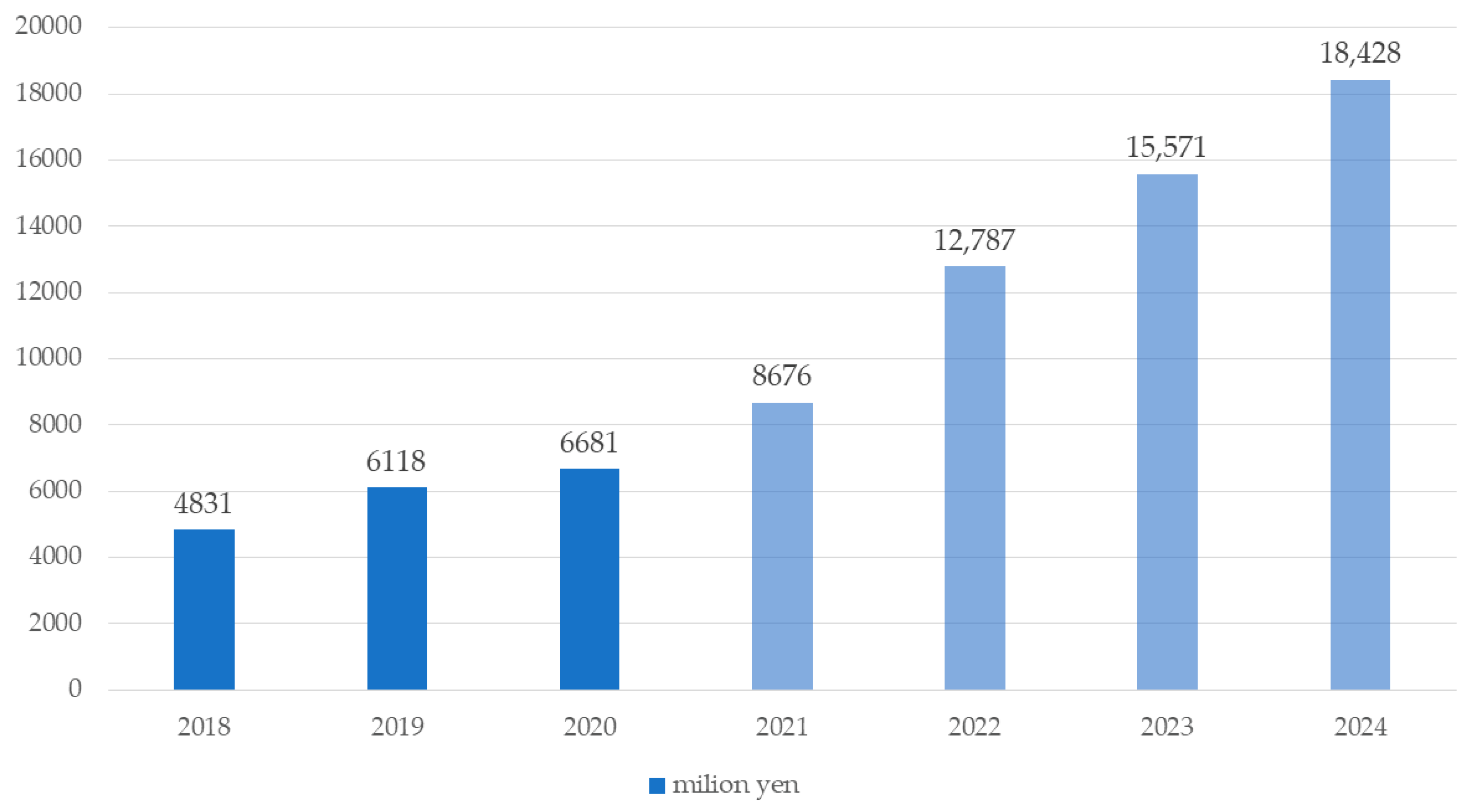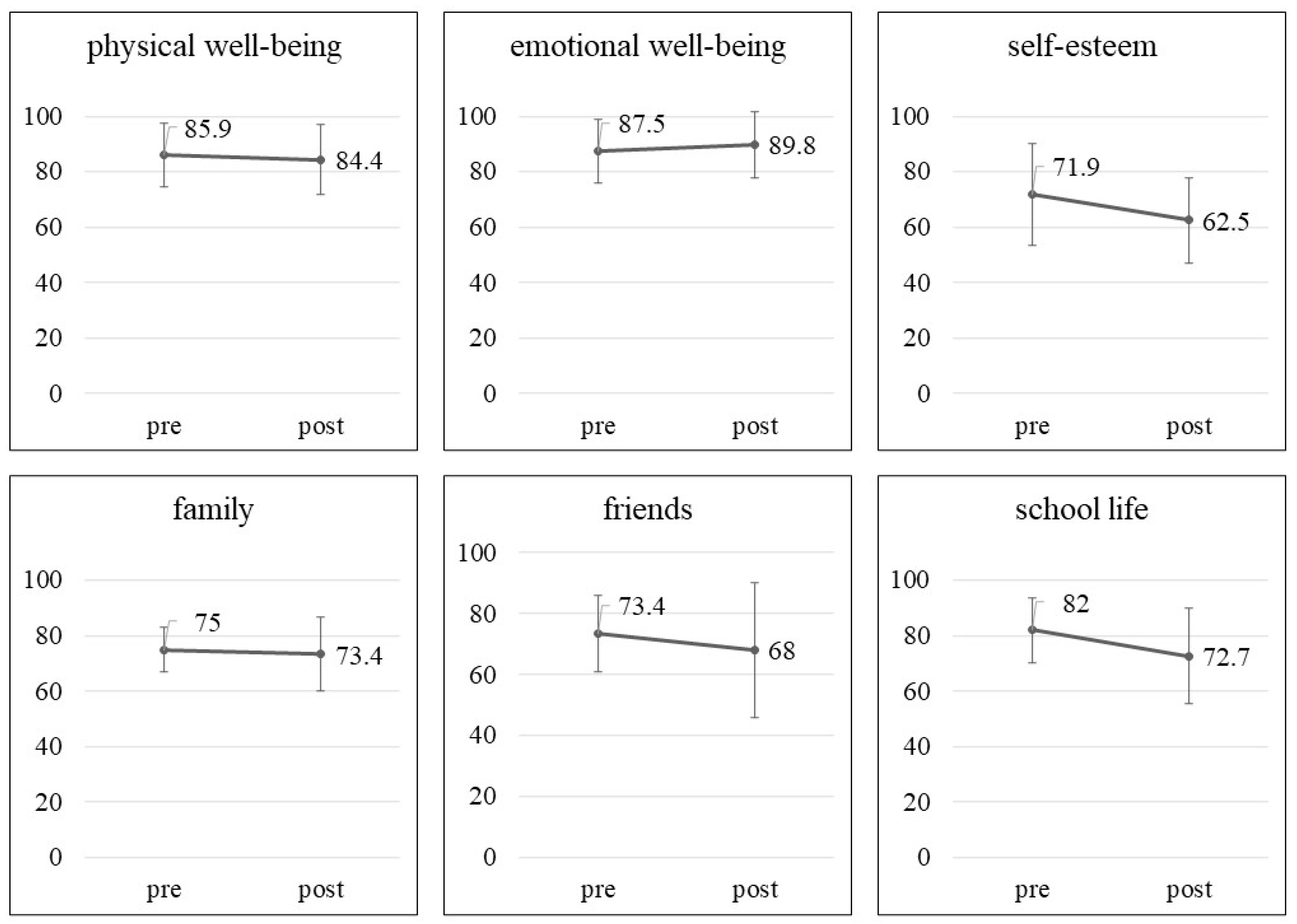Influence of an Esports Program on Problematic Gaming in Children with Autistic Spectrum Disorder: A Pilot Study
Abstract
:1. Introduction
2. Materials and Methods
2.1. Participants and Design
2.2. Procedure
2.3. Instruments
Internet Gaming Disorder Test (IGD-20 Test)
2.4. Statistical Analyses
3. Results
4. Discussion
Author Contributions
Funding
Institutional Review Board Statement
Informed Consent Statement
Data Availability Statement
Acknowledgments
Conflicts of Interest
References
- Ang, C.S. Rules, gameplay, and narratives in video games. Simul. Gaming 2006, 37, 306–325. [Google Scholar] [CrossRef]
- Funk, D.C.; Pizzo, A.D.; Baker, B.J. eSport management: Embracing eSport education and research opportunities. Sport Manag. Rev. 2018, 21, 7–13. [Google Scholar] [CrossRef]
- Chung, T.; Sum, S.; Chan, M.; Lai, E.; Cheng, N. Will Esports Result in a Higher Prevalence of Problematic Gaming? A Review of the Global Situation. J. Behav. Addict. 2019, 8, 384–394. [Google Scholar] [CrossRef] [PubMed]
- Hallmann, K.; Giel, T. eSports–Competitive sports or recreational activity? Sport Manag. Rev. 2018, 21, 14–20. [Google Scholar] [CrossRef]
- Japan Esports Prefectural Tournament. Available online: https://esports.sega.jp/2022tochigi/ (accessed on 1 May 2022).
- ALL JAPAN High School Esports Championship. Available online: https://www.ajhs-esports.jp/ (accessed on 1 May 2022).
- The National High School Esports Tournament. Available online: https://stage0.jp/ (accessed on 1 May 2022).
- Johnson, M.R.; Woodcock, J. Work, play, and precariousness: An overview of the labour ecosystem of esports. Media Cult. Soc. 2021, 43, 1449–1465. [Google Scholar] [CrossRef]
- Newzoo Global Esports & Live Streaming Market Report. Available online: https://newzoo.com/insights/trend-reports/newzoos-global-esports-live-streaming-market-report-2021-free-version/ (accessed on 1 May 2022).
- KADOKAWA Game Linkage Report. Available online: https://www.kadokawa.co.jp/topics/5695/ (accessed on 1 May 2022).
- Komatsu, M.; Matsumoto, T.; Prowant, C. Learning through esports in innovation practice on electrical technology. Procedia Comput. Sci. 2021, 192, 2550–2557. [Google Scholar] [CrossRef]
- Hassan, M.; Shimizu, Y.; Hada, Y.; Suzuki, K. Joy-Pros: A Gaming Prosthesis to Enable Para-Esports for Persons with Upper Limb Deficiencies. IEEE Access. 2022, 10, 18933–18943. [Google Scholar] [CrossRef]
- Yoon, T.H.; Eun, D.; Park, S.; Koo, C.; Jee, Y. eSports Can Enhance Sociality and Physical Fitness in Children with Intellectual Disability. Transylv. Rev. 2018, 26, 30. [Google Scholar]
- Chan, G.; Huo, Y.; Kelly, S.; Leung, J.; Tisdale, C.; Gullo, M. The impact of eSports and online video gaming on lifestyle behaviours in youth: A systematic review. Comput. Hum. Behav. 2022, 126, 106974. [Google Scholar] [CrossRef]
- World Health Organization. International Statistical Classification of Diseases and Related Health Problems (11th Revision). 2019. Available online: https://icd.who.int/browse11/l-m/en (accessed on 8 April 2022).
- King, D.L.; Delfabbro, P.H.; Perales, J.C.; Deleuze, J.; Király, O.; Krossbakken, E.; Billieux, J. Maladaptive Player-Game Relationships in Problematic Gaming and Gaming Disorder: A Systematic Review. Clin. Psychol. Rev. 2019, 73, 101777. [Google Scholar] [CrossRef]
- Coutelle, R.; Weiner, L.; Paasche, C.; Pottelette, J.; Bertschy, G.; Schröder, C.M.; Lalanne, L. Autism Spectrum Disorder and Video Games: Restricted Interests or Addiction? Int. J. Ment. Health Addict. 2021. [Google Scholar] [CrossRef]
- Saito, M.; Hirota, T.; Sakamoto, Y.; Adachi, M.; Takahashi, M.; Osato-Kaneda, A.; Nakamura, K. Prevalence and cumulative incidence of autism spectrum disorders and the patterns of co-occurring neurodevelopmental disorders in a to-tal population sample of 5-year-old children. Mol. Autism 2020, 11, 35. [Google Scholar] [CrossRef]
- Baio, J.; Wiggins, L.; Christensen, D.L.; Maenner, M.J.; Daniels, J.; Warren, Z.; Dowling, N.F. Prevalence of autism spectrum disorder among children aged 8 years—Autism and developmental disabilities monitoring network, 11 sites, United States, 2014. MMWR Surveill. Summ. 2018, 67, 1–23. [Google Scholar] [CrossRef]
- Bryn, V.; Verkerk, R.; Skjeldal, O.H.; Saugstad, O.D.; Ormstad, H. Kynurenine pathway in autism spectrum disorders in children. Neuropsychobiology 2017, 76, 82–88. [Google Scholar] [CrossRef]
- Török, N.; Tanaka, M.; Vécsei, L. Searching for Peripheral Biomarkers in Neurodegenerative Diseases: The Trypto-phan-Kynurenine Metabolic Pathway. Int. J. Mol. Sci. 2020, 21, 9338. [Google Scholar] [CrossRef]
- Meltzer, A.; Van de Water, J. The Role of the Immune System in Autism Spectrum Disorder. Neuropsychopharmacology 2017, 42, 284–298. [Google Scholar] [CrossRef] [Green Version]
- Craig, F.; Tenuta, F.; De Giacomo, A.; Trabacca, A.; Costabile, A. A Systematic Review of Problematic Video-Game Use in People with Autism Spectrum Disorders. Res. Autism Spectr. Disord. 2021, 82, 101726. [Google Scholar] [CrossRef]
- Paulus, F.W.; Sander, C.S.; Nitze, M.; Kramatschek-Pfahler, A.R.; Voran, A.; von Gontard, A. Gaming Disorder and Computer-Mediated Communication in Children and Adolescents with Autism Spectrum Disorder. Z. Kinder Jugendpsychiatr. Psychother. 2020, 48, 113–122. [Google Scholar] [CrossRef]
- Kitaoka, T.; Morimoto, M.; Hashimoto, T.; Tsuda, Y.; Nakatsu, T.; Kyotani, S. Evaluation of the Efficacy of Drug Treatment Based on Measurement of the Oxidative Stress, Using Reactive Oxygen Metabolites and Biological Antioxidant Potential, in Children with Autism Spectrum Disorder and Attention Deficit Hyperactivity Disorder. J. Pharm. Health Care Sci. 2020, 6, 8. [Google Scholar] [CrossRef]
- Pontes, H.M.; Király, O.; Demetrovics, Z.; Griffiths, M.D. The Conceptualisation and Measurement of DSM-5 Internet Gaming Disorder: The Development of the IGD-20 Test. PLoS ONE 2014, 9, e110137. [Google Scholar] [CrossRef] [Green Version]
- Ravens-Sieberer, U.; Bullinger, M. Assessing Health-Related Quality of Life in Chronically Ill Children with the German KINDL: First Psychometric and Content Analytical Results. Qual. Life Res. 1998, 7, 399–407. [Google Scholar] [CrossRef]
- Furusho, J.; Shibata, R.; Nemoto, Y.; Matsuzaki, K. QOL Measure in Children. Understanding and Application: To Evaluate Physical and Mental Health, KINDL Japanese Version; Shindantochiryosha: Tokyo, Japan, 2014; pp. 1–25. (In Japanese) [Google Scholar]
- Erhart, M.; Ellert, U.; Kurth, B.M.; Ravens-Sieberer, U. Measuring adolescents’ HRQoL via self reports and parent proxy reports: An evaluation of the psychometric properties of both versions of the KINDL-R instrument. Health Qual. Life Outcomes 2009, 7, 77. [Google Scholar] [CrossRef] [Green Version]
- Lin, C.Y.; Luh, W.M.; Cheng, C.P.; Yang, A.L.; Ma, H.I. Evaluating the wording effect and psychometric properties of the Kid-KINDL. Eur. J. Psychol. Assess. 2013, 30, 100–109. [Google Scholar] [CrossRef]
- Şalvarlı, Ş.İ.; Griffiths, M.D. Internet Gaming Disorder and Its Associated Personality Traits: A Systematic Review Using PRISMA Guidelines. Int. J. Ment. Health Addict. 2021, 19, 1420–1442. [Google Scholar] [CrossRef] [Green Version]
- Anderson, C.A.; Suzuki, K.; Swing, E.L.; Groves, C.L.; Gentile, D.A.; Prot, S.; Lam, C.P.; Sakamoto, A.; Horiuchi, Y.; Krahé, B.; et al. Media Violence and Other Aggression Risk Factors in Seven Nations. Pers. Soc. Psychol. Bull. 2017, 43, 986–998. [Google Scholar] [CrossRef]
- Hartanto, A.; Lua, V.Y.; Quek, F.Y.; Yong, J.C.; Ng, M.H. A critical review on the moderating role of contextual factors in the associations between video gaming and well-being. Comput. Hum. Behav. Rep. 2021, 4, 100135. [Google Scholar] [CrossRef]
- Mazurek, M.O.; Engelhardt, C.R. Video Game Use in Boys with Autism Spectrum Disorder, ADHD, or Typical Development. Pediatrics 2013, 132, 260–266. [Google Scholar] [CrossRef] [Green Version]
- Kawabe, K.; Hosokawa, R.; Nakachi, K.; Yoshino, A.; Horiuchi, F.; Ueno, S.I. Excessive and Problematic Internet Use During the Coronavirus Disease 2019 School Closure: Comparison Between Japanese Youth with and Without Autism Spectrum Disorder. Front. Public Health 2020, 8, 609347. [Google Scholar] [CrossRef]
- Palanichamy, T.; Sharma, M.K.; Sahu, M.; Kanchana, D.M. Influence of Esports on Stress: A Systematic Review. Ind. Psychiatry J. 2020, 29, 191–199. [Google Scholar] [CrossRef] [PubMed]
- Chamarro, A.; Oberst, U.; Cladellas, R.; Fuster, H. Effect of the Frustration of Psychological Needs on Addictive Behaviors in Mobile Videogamers-the Mediating Role of Use Expectancies and Time Spent Gaming. Int. J. Environ. Res. Public Health 2020, 17, 6429. [Google Scholar] [CrossRef]
- Freeman, G.; Wohn, D.Y. Social support in eSports: Building emotional and esteem support from instru-mental support interactions in a highly competitive environment. In Proceedings of the Annual Symposium on Computer Human Interaction in Play, Amsterdam, The Netherlands, 15–18 October 2018; pp. 435–447. [Google Scholar]
- Shum, H.L.; Lee, C.H.; Cheung, J.C.S. Should Esports Be a Co-Curricular Activity in School? Child. Sch. 2021, 43, 61–63. [Google Scholar] [CrossRef]
- Sundberg, M. Online Gaming, Loneliness and Friendships Among Adolescents and Adults With ASD. Comput. Hum. Behav. 2018, 79, 105–110. [Google Scholar] [CrossRef]
- Um, Y.; Iskenderian, N.; Liu, J. Digital Media Use and Its Implication for Sleep Disruption in Patients With ASD: A Qualitative Review with a Focus on the COVID19 Pandemic. N. Am. J. Med. Sci. 2021, 1, 12–20. [Google Scholar] [CrossRef]


| No. | Age, Years | Sex | Diagnosis | Duration of Gaming at Home (Weekday, min) | Duration of Gaming at Home (Weekend, min) | IGD-20 | Kid-KINDL | ||||||||||||||
|---|---|---|---|---|---|---|---|---|---|---|---|---|---|---|---|---|---|---|---|---|---|
| Physical Well-Being | Emotional Well-Being | Self-Esteem | Family | Friends | School Life | ||||||||||||||||
| pre | post | pre | post | pre | post | pre | post | pre | post | pre | post | pre | post | pre | post | pre | post | ||||
| 1 | 7 | Boy | ASD | 0 | 0 | 120 | 120 | 43 | 39 | 87.5 | 100 | 62.5 | 68.8 | 62.5 | 62.5 | 81.3 | 68.8 | 68.8 | 75 | 62.5 | 75 |
| 2 | 8 | Boy | ASD | 0 | 0 | 90 | 120 | 42 | 60 | 100 | 68.8 | 87.5 | 93.8 | 75 | 93.8 | 81.3 | 68.8 | 93.8 | 87.5 | 87.5 | 87.5 |
| 3 | 9 | Boy | ASD | 0 | 0 | 120 | 60 | 39 | 27 | 81.3 | 87.5 | 87.5 | 100 | 93.8 | 62.5 | 87.5 | 75 | 81.3 | 87.5 | 87.5 | 81.3 |
| 4 | 12 | Boy | ASD | 10 | 20 | 20 | 35 | 36 | 24 | 75 | 62.5 | 100 | 93.8 | 87.5 | 62.5 | 68.8 | 100 | 87.5 | 25 | 87.5 | 75 |
| 5 | 6 | Boy | ASD/ ADHD | 60 | 120 | 120 | 360 | 44 | 48 | 100 | 87.5 | 100 | 87.5 | 87.5 | 56.3 | 75 | 62.5 | 62.5 | 68.8 | 100 | 68.8 |
| 6 | 7 | Boy | ASD/ ADHD | 30 | 30 | 120 | 120 | 48 | 47 | 81.3 | 87.5 | 87.5 | 100 | 62.5 | 62.5 | 62.5 | 75 | 62.5 | 87.5 | 81.3 | 62.5 |
| 7 | 9 | Boy | ASD/ ADHD | 0 | 0 | 0 | 0 | 24 | 31 | 68.8 | 87.5 | 87.5 | 100 | 37.5 | 37.5 | 75 | 56.3 | 68.8 | 62.5 | 81.3 | 93.8 |
| 8 | 12 | Boy | ASD/ ADHD | 0 | 0 | 120 | 120 | 47 | 42 | 93.8 | 93.8 | 87.5 | 75 | 68.8 | 62.5 | 68.8 | 81.3 | 62.5 | 50 | 68.8 | 37.5 |
Publisher’s Note: MDPI stays neutral with regard to jurisdictional claims in published maps and institutional affiliations. |
© 2022 by the authors. Licensee MDPI, Basel, Switzerland. This article is an open access article distributed under the terms and conditions of the Creative Commons Attribution (CC BY) license (https://creativecommons.org/licenses/by/4.0/).
Share and Cite
Kawabe, K.; Horiuchi, F.; Hosokawa, R.; Nakachi, K.; Soga, J.; Ueno, S.-i. Influence of an Esports Program on Problematic Gaming in Children with Autistic Spectrum Disorder: A Pilot Study. Behav. Sci. 2022, 12, 172. https://doi.org/10.3390/bs12060172
Kawabe K, Horiuchi F, Hosokawa R, Nakachi K, Soga J, Ueno S-i. Influence of an Esports Program on Problematic Gaming in Children with Autistic Spectrum Disorder: A Pilot Study. Behavioral Sciences. 2022; 12(6):172. https://doi.org/10.3390/bs12060172
Chicago/Turabian StyleKawabe, Kentaro, Fumie Horiuchi, Rie Hosokawa, Kiwamu Nakachi, Junya Soga, and Shu-ichi Ueno. 2022. "Influence of an Esports Program on Problematic Gaming in Children with Autistic Spectrum Disorder: A Pilot Study" Behavioral Sciences 12, no. 6: 172. https://doi.org/10.3390/bs12060172
APA StyleKawabe, K., Horiuchi, F., Hosokawa, R., Nakachi, K., Soga, J., & Ueno, S.-i. (2022). Influence of an Esports Program on Problematic Gaming in Children with Autistic Spectrum Disorder: A Pilot Study. Behavioral Sciences, 12(6), 172. https://doi.org/10.3390/bs12060172






